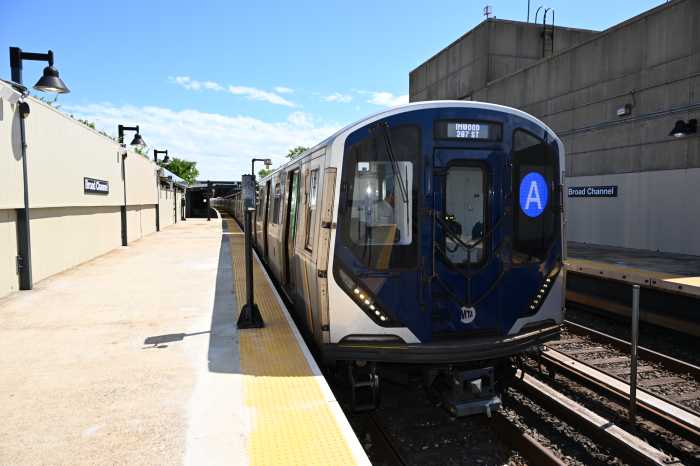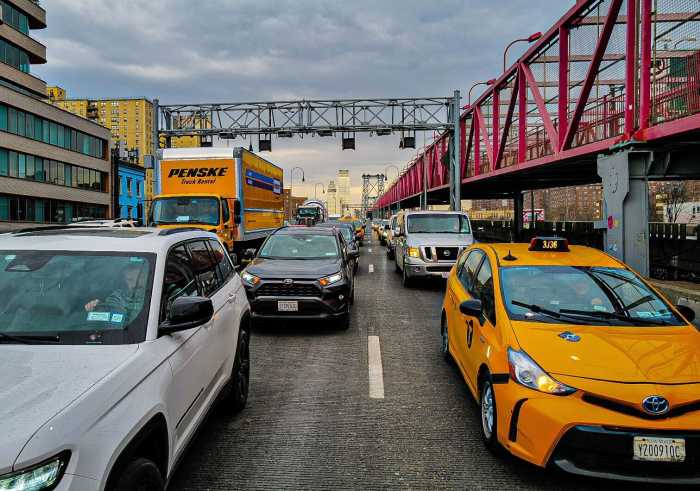Unbiased candidate former New York Gov. Andrew Cuomo, Republican candidate Curtis Sliwa and Democratic candidate Assemblyman Zohran Mamdani take part in a second New York Metropolis mayoral debate on the LaGuardia Performing Arts Middle at LaGuardia Group School in Lengthy Island Metropolis, Queens, New York, October 22, 2025. Hiroko Masuike/Pool by way of REUTERS
As New Yorkers put together to vote, one subject quietly shapes almost each facet of metropolis life: how we transfer. Streets, subways, buses, taxis, and for-hire autos don’t at all times seize as a lot consideration as housing or public security, however the subsequent mayor could have great affect over the transportation programs that have an effect on hundreds of thousands of residents, staff, and guests every single day.
This election cycle, the College Transportation Analysis Middle (UTRC) has once more produced an evaluation of the mayoral candidates’ transportation data and proposals, titled 2025 NYC Mayoral Candidates Transportation Coverage Primer & Voter Information. Primarily based on the Metropolis School of New York and representing the U.S. Division of Transportation Area II, the UTRC was established in 1987 to advance analysis, training, and expertise switch in transportation. The purpose of the report and the accompanying palm card distributed to voters is to offer a transparent comparability of the main candidates—Andrew Cuomo, Zohran Mamdani, and Curtis Sliwa – throughout transportation subject areas.
The methodology follows the identical method utilized in earlier editions from 2013 and 2021. Every report is peer-reviewed by transportation specialists and based mostly totally on publicly accessible supplies, together with marketing campaign platforms, laws, press statements, official data in addition to responses to surveys from the candidates’ campaigns. The palm card presents a one-page overview of candidate positions, serving as a reference for voters and policymakers.
The subsequent mayor will inherit an formidable and sophisticated transportation agenda. The town is increasing zero-emission necessities for for-hire autos, working to make bus service quicker and extra dependable, managing competing calls for for curb and avenue area, and persevering with the Imaginative and prescient Zero initiative to eradicate visitors fatalities. These points collectively replicate broader priorities round fairness, security, sustainability, and financial vitality.
 Picture by Ramy Mahmoud
Picture by Ramy Mahmoud
Former Gov. Andrew Cuomo has emphasised expertise and practicality in his marketing campaign. His transportation file contains launching congestion pricing, approving main accessibility investments within the MTA’s capital plan, and signing laws legalizing e-bikes and scooters. Cuomo’s present platform highlights deploying police to subway stations and trains to enhance subway security, increasing free bus and subway fares for low-income New Yorkers, and creating an business advisory committee to evaluate outdated Taxi & Limousine Fee (TLC) laws. He has additionally urged the town to proceed cautiously with its electric-vehicle mandates till charging infrastructure is enough to help the transition.
Meeting Member Zohran Mamdani has constructed his platform round affordability and livability. He has made free and quick bus service a central plank of his marketing campaign. As well as he has referred to as for stronger delivery-worker protections, and extra protected bike lanes. In Albany, Mamdani co-authored the 2023–24 fare-free bus pilot and sponsored laws to automate enforcement towards autos that block bike lanes. His marketing campaign additionally proposes eliminating parking minimums citywide, shifting visitors enforcement from the New York Police Division to the town Division of Transportation, and rising using automated security cameras. Mamdani’s method connects transportation to broader problems with social justice.
Curtis Sliwa, who additionally ran within the 2021 mayoral race (and whose positions had been set forth 4 years in the past in our final report) has now centered additionally on restoring order and addressing what he describes as quality-of-life points. His platform emphasizes enforcement towards reckless cyclists, towing of deserted autos, and elevated NYPD presence on subways and at stations. Sliwa opposes congestion pricing and favors expanded express-bus service over fare-free applications. His positions replicate a concentrate on public security and primary service supply somewhat than new infrastructure initiatives. Sliwa additionally requires higher NYPD enforcement and bodily measures resembling raised crosswalks and pace humps close to faculties to deal with avenue security.
 Congestion pricing toll gantries on the Williamsburg Bridge. Picture by Dean Moses
Congestion pricing toll gantries on the Williamsburg Bridge. Picture by Dean Moses
The candidates have various opinions on the congestion pricing program. Cuomo initially championed the coverage as governor to fund the MTA and scale back gridlock, and presently helps it. Nevertheless, in 2024, he did name for the implementation to be delayed citing considerations in regards to the metropolis’s financial restoration from the pandemic. Mamdani has constantly supported the tolling program, citing its environmental advantages and the worth of the income to the MTA. Sliwa has constantly opposed this system, and proposes rebates for metropolis residents who pay the toll.
The candidates additionally differ in how they view curb administration and the general public realm. Cuomo would concentrate on streamlining outdoor-dining allowing. Mamdani requires growth of out of doors eating, eradicating parking close to intersections to enhance driver visibility of pedestrians (known as “daylighting”), expanded open-street applications, and extra bike lanes. Sliwa helps requiring eating places to higher keep their outside eating amenities and elevated enforcement of parking guidelines.
Transportation coverage usually reveals extra a couple of chief’s priorities than their marketing campaign slogans. Many of those initiatives would require coordination and negotiation with state and regional companions, resembling working with the MTA on transit service and Con Edison on constructing electric-vehicle infrastructure. How effectively the following administration manages these relationships will decide whether or not formidable objectives translate into significant progress.
For the taxi and for-hire automobile sector, transportation selections will proceed to form financial stability and workforce situations. Driver pay guidelines, the cap on the variety of for-hire autos, and the availability of taxi reduction stands all require collaboration between the town and business leaders. New freight and private supply applications and guidelines could must be developed on account of the exponential progress in e-commerce deliveries.
This broad array of transportation points could not dominate the candidates’ marketing campaign speeches, however the subsequent administration’s selections on these points will affect each New Yorker’s each day expertise. The UTRC report and palm card provide voters an goal reference level to match the candidates’ positions and perceive their broader philosophies. Mobility is the muse of New York’s financial system and high quality of life.
Whoever takes workplace on Jan. 1, 2026 will face the continued activity of conserving the town shifting safely, effectively, and equitably for everybody.
Matthew Daus is the transportation expertise chair for the College Transportation Analysis Middle, Area 2 (NY/NJ) on the Metropolis College of New York






